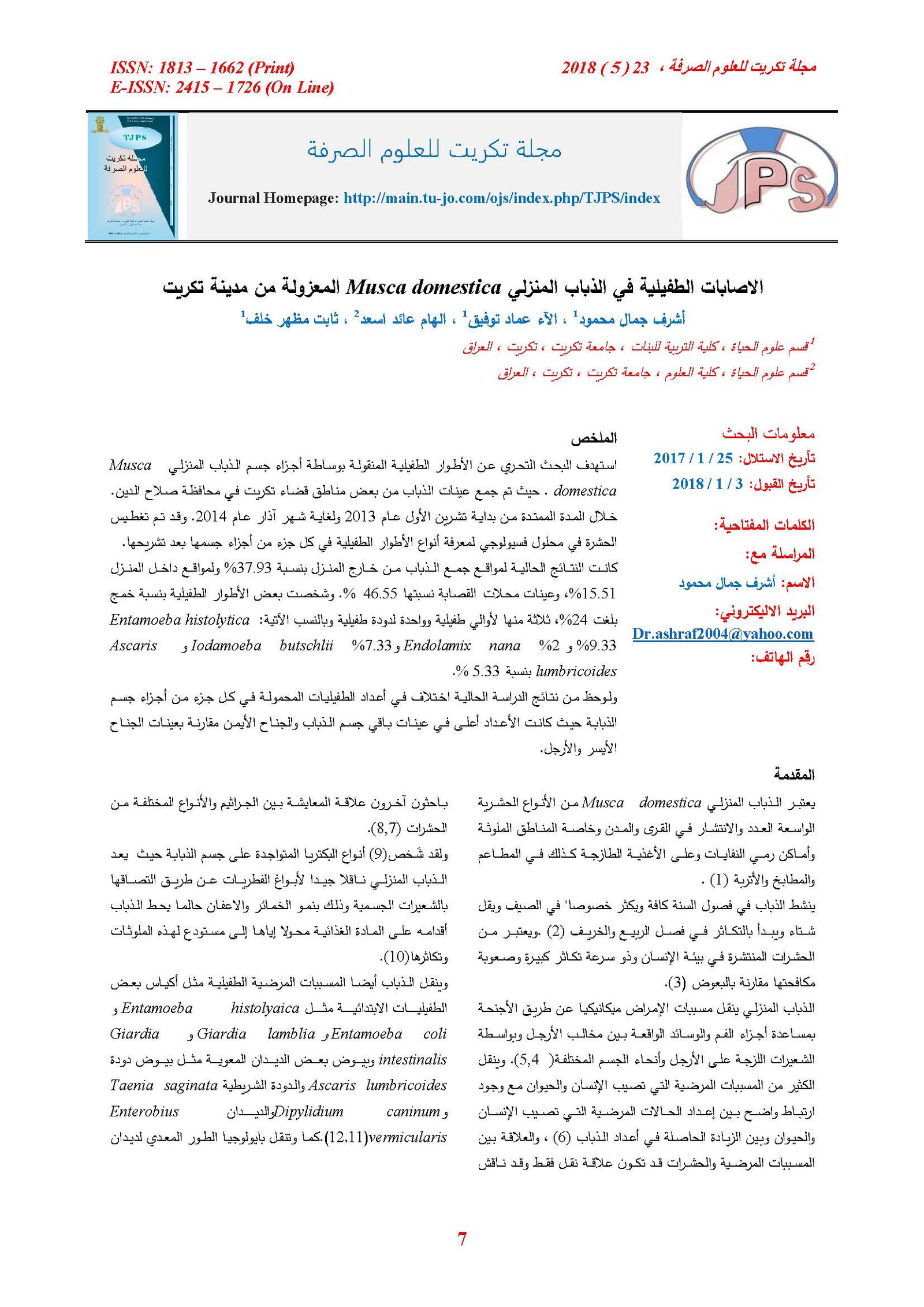parasitic infection in Musca domestica which isolated from Tikrit city
Main Article Content
Abstract
The targeted of this research is investigating the parasitic stages transmitted by body houseflies parts Musca domestica. Where samples were collected from some areas of Tikrit city in Salahuddin province. from October 2013 until January 2014. through immersion insect in physiological solution to see the types of parasitic stages.
where the proportion for sites of outside home 37.93% while the sites of inside house rate was 15.51%, and samples of butcher shops rate was 46.55%.And diagnosed some parasitic stages and the rate of infection was 24%, the parasites are: Entamoeba histolytica 9.33%, Endolamix nana 2% , Iodamoeba butschlii 7.33% and egg Ascaris lumbricoides 5.33%.
The results also show that the number of parasitic flies on the body of roles after dipping lower than before dowsing, and these numbers vary from part to part, where the setup was more, especially in the rest of the body samples flies right wing and the left wing and legs samples were prepared less.
Article Details

This work is licensed under a Creative Commons Attribution 4.0 International License.
Tikrit Journal of Pure Science is licensed under the Creative Commons Attribution 4.0 International License, which allows users to copy, create extracts, abstracts, and new works from the article, alter and revise the article, and make commercial use of the article (including reuse and/or resale of the article by commercial entities), provided the user gives appropriate credit (with a link to the formal publication through the relevant DOI), provides a link to the license, indicates if changes were made, and the licensor is not represented as endorsing the use made of the work. The authors hold the copyright for their published work on the Tikrit J. Pure Sci. website, while Tikrit J. Pure Sci. is responsible for appreciate citation of their work, which is released under CC-BY-4.0, enabling the unrestricted use, distribution, and reproduction of an article in any medium, provided that the original work is properly cited.
References
1-Nylen, G.; Dunstan. F.; Palmer. S.; Andersson, Y.; Bager, F.; Cowden, J Feierl, G.; Galloway, Y.; Kapperud G.; Megraud, F.; Mplbak, K.; Petersen, L. and Ruutu, P. (2002). The seasonal distribution of campylobac infection in nine European countrie and New Zealand .Epi .Infect . 128.
2-Brian, M .W.; David, K. (2003) . " Time flies , anew molecular time – scale for brachceran fly evolution without a clock " . systematic biology ., 52 (6) : 745-756.
4-Scott, J. G.; Alefantis, T,G.; Kaufman, P.E. and Rutz, D. (2003). " Insecticide resistance in house flies from caged – lay . poultryfacilities" Pest Management science .56 ( 147 – 153 ).
5-Dame, D. & Fasculo, T. R. (2003). Flies .public Health pesticide Applicator Training Manual. New York. USA.
6-Lysyk, T.J. (2000). Comparision of sample units for estima population abundance and rate of change of adult horn Haematobiairritas (Diptera: Muscidae). J. Med. Entomol . 37:299-307.
7-Fouda, M. (1984). Significance of symbiotic in Hippoboscia equine (Diptera, Hippoboscidae) ZAUG Ent. 97 : 376-378 .
8-Breznak, A.(1982). Intesinalmicrobiota of termites and otherxolophagousinsets . Ann. Rev .Microbio., 36: 323-343 .
9-Greang, P.D.; Vinson, S.B. and Lewis, W.J. (1984). Insect Parasitoids: Finding new opportunities for biological control . Bioscience .34 : 690 -696.
10-Kaufman, P.E.; Rutz, D.A. and Waldron, J.K. (2005). Common pest flies found in the urban /rural environment and their biological control agents .cornell University I thaca , N Y .
14-Honda, Y., Jeki, M., Okada, G.; Onose, R.; Usami, R.; Horikoshi K and Osads, H. (2004). Isolation and biological property of a new cell cycle in hibitor ,Curvularol , isolated from Curvularia sp. RK 97 – F 166. J. Antib., 54: 10 -16 .
15-Gupte, S. (1984) . The short text book of Medical Microbiology .2thed. New York , USA.
19-Muel, M.C.; Vugia, D.J. Shallow, S.; Marcus, R.; Segler, S.; McGivern, T.; Kassenborg, H.; Reilly, K.; Kennedy, M.; Angulo, J. and Tauxe, R.V. (2004). Emerging infection program food Net Working Group. Epidemiology of sporadic campy lobacter infection in the United states and declining lend in incidence, Food Net 1996-1999. ClinInfect. Dis.; 38 : S ( 165-174 ).
20-Hadi, A. M. (2011). Astudy of prevalence of some parasites and protozoa from Muscadomesticain Baghdad. University of Baghdad.
21-Al-Najjar, R.K. (1993). Prevalence of intestinal protozoa in primary school children Numania district
ISSN: 1813 – 1662 (Print) 2018 ) 5 ( مجلة تكريت للعلوم الصرفة ، 23
E-ISSN: 2415 – 1726 (On Line)
12
west governorate, Diploma. Med. Thes., Coll. Med. Unive. Of Saddam.
22-Ahmad, M.; Hassan, M. & Zayed, A. (1995). Microbial floraassociation with some species of biting and non species of biting and nonbiting flies (Diptera). J.Sci. Edu., 20: 477-489.
